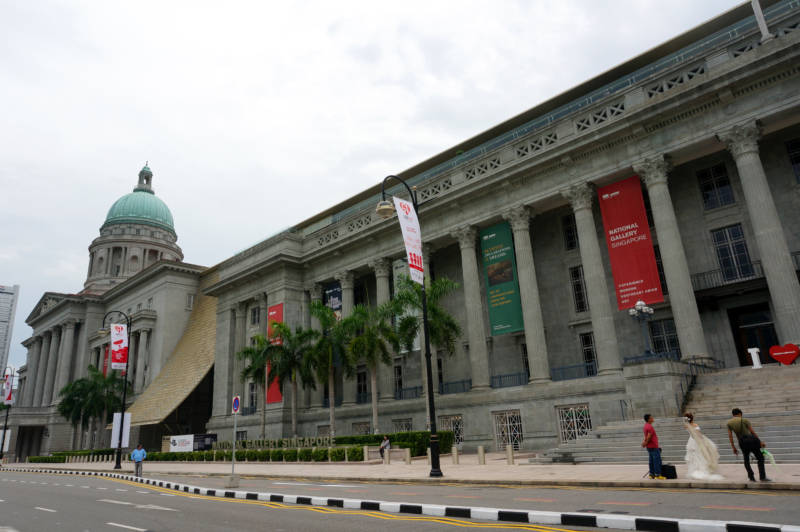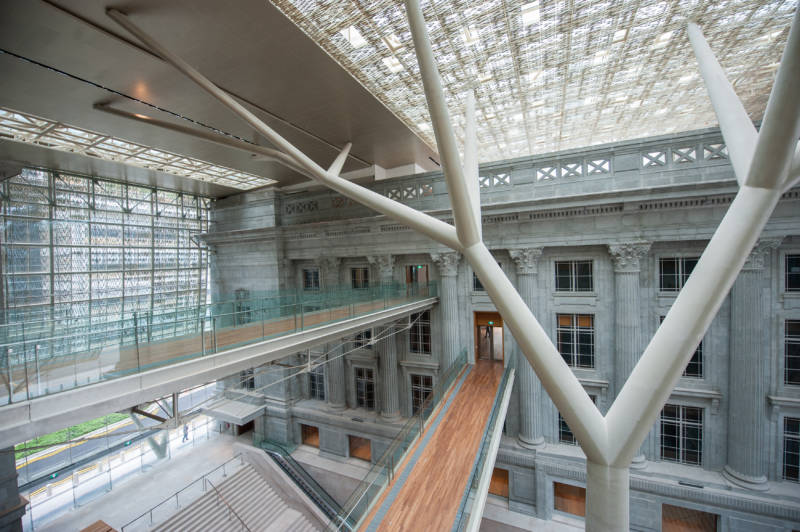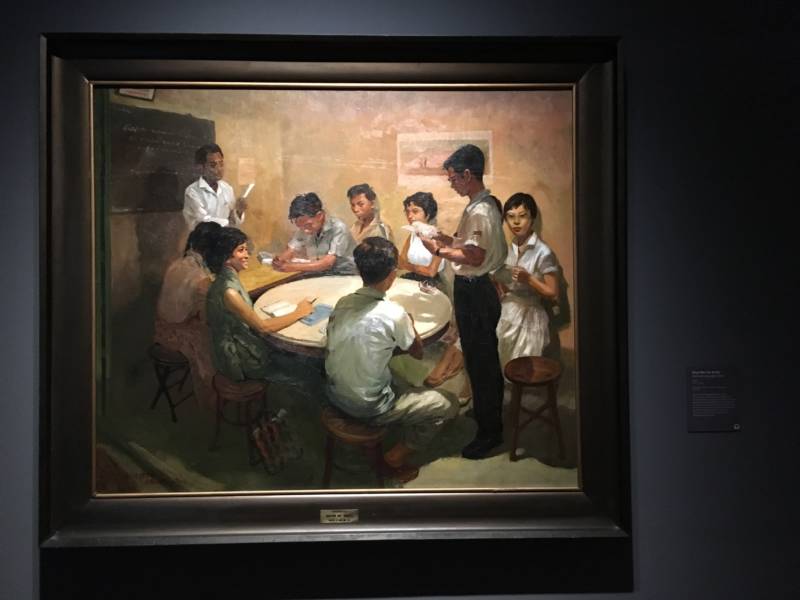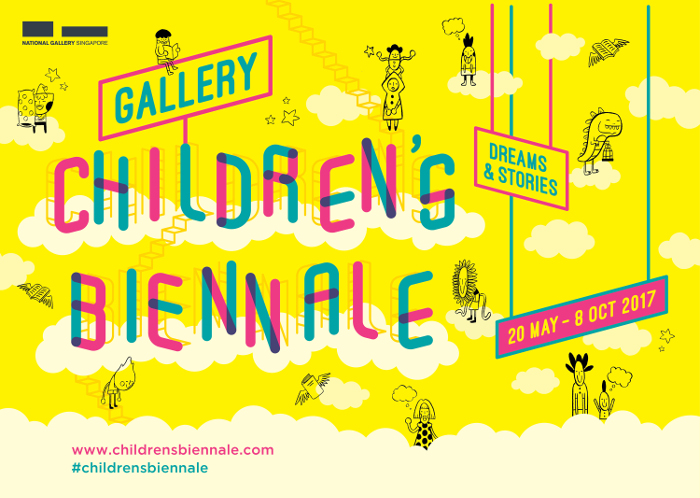【亞太博物館連線專欄】貴姓大名?(Siapa Nama Kamu)新加坡國家美術館的生成
What is Your Name? (Siapa Nama Kamu) The Making of National Gallery Singapore
貴姓大名?(Siapa Nama Kamu)新加坡國家美術館的生成
What is Your Name? (Siapa Nama Kamu) The Making of National Gallery Singapore
作者:辛友仁(新加坡國家美術館資深策展人)
我們對博物館的要求是什麼、博物館對民間社會又負有什麼樣的責任呢?新加坡國家美術館於2015年11月24日開幕,正逢建國獨立50週年紀念日。值此時刻,正是新加坡這個城市國家應當對藝術及其文化認同間之關係,進行批判性反思的好時機。本文試圖以公民使命的角度來檢視國家美術館的潛力和可能性,而具統整性與重要性的文化性辯論,是公民機構網絡中會自然發生的一部分,將在公民社會裡發揮關鍵作用和責任。
關鍵字:社會責任、公民機構、身分認同、地方性、文化本位
編按:本文原為英文,由亞太博物館連線計畫團隊翻譯為中文。
2015對新加坡而言是具有歷史重要性的一年,標誌著其獨立50週年。新加坡國家美術館(以下簡稱國家美術館)在2015年11月24日的開幕來得正是時候,因為它為城市國家提供了對其藝術及在地文化認同關係的批判性反思良機。國家美術館開幕時即設有兩檔常設展覽,一檔是「貴姓大名?(Siapa Nama Kamu?):19世紀以來的新加坡藝術」,另一檔則是「在宣言與夢想之間:19世紀以來東南亞藝術」,兩個常設展都展出超過800件的藝術作品,展品一部分來自國家文物局典藏,另一部分則是向其他博物館和私人收藏家商借而來。新加坡國家美術館開館已屆兩年,館長陳維德(Eugene Tan)在接受《澎湃新聞•藝術評論》(The Paper)採訪時表示:「美術館必須要轉型成為能夠討論有爭議性的社會文化問題的平台。」(註一)國家美術館擁有作為公民視野展望的論述場所,而具統整性與重要性的文化性辯論,是公民機構網絡中會自然發生的一部分,將在公民場域裡發揮關鍵作用和責任。在針對爭議性議題相對缺乏公開討論平台的狀況下,藝術有潛力為新加坡提供所需的論述空間,在這裡議題可以與想像力共存同榮。


圖中視野為從昔日最高法院望向市政廳大樓。(來源: https://www.nationalgallery.sg/about/news/press-room/image-gallery/building-spaces)
事實上,國家美術館具有公民機構的視野,和以馬來文命名的展覽「貴姓大名?(Siapa Nama Kamu?)」之間就因為兩層原因形成了更多的共鳴。第一層原因,是展覽標題竟運用提問句,這明顯是帶有挑釁意味的策展手法,希望能激發原本被動的觀眾,重新去定義和反思自己目前所習慣的約定俗成與慣例。其二,在於命名與被命名的權力。我們的名字與己身的文化及身分認同是密不可分的,而名字又與我們的語言息息相關。選擇以馬來語提問—馬來語是新加坡的國家語言,卻因華人仍然佔新加坡人口的多數,而成為一個未能在新加坡全國被普遍傳授的國家語言-重塑了我們的新加坡身分認同。採用馬來語作為國家語言,可追溯到以馬來文作為國語的馬來亞身分認同,馬來文在1950年代至1965年期間是眾人渴求學會的語言,但當新加坡脫離開馬來西亞獨立時,這種渴求就消失了。對馬來文展覽標題的陌生感會製造觀眾的不安,這正是策展人的策略,試圖激發觀者的批判性思考。正是出於這些原因,這次的展覽「貴姓大名?(Siapa Nama Kamu?)」被用來作為切入點,讓觀眾理解國家美術館作為公民機構的一環,擔負著連結重要社會及文化議題的責任。
「貴姓大名?(Siapa Nama Kamu?)」這個展覽標題,衍生自新加坡藝術家蔡名智(Chua Mia Tee)的作品《上國語課》(National Language Class),該畫作繪於1959年,並在本次展覽中特別被突顯出來。這幅畫描繪了華人學生向馬來人老師學習馬來語的課堂,教室裡的黑板就潦草地寫著「Siapa Nama Kamu?(你叫什麼名?)」以及「Di mana awak tinggal(你住在哪裡?)」。命名和地方性的權力,是了解新加坡國家美術館策展和研究方向的有效切入點。以馬來文提問名字的問題,指涉的歷史時刻,是那個馬來亞文化疆域尚包括新加坡、馬來半島和婆羅洲在內的時代,當時這種想像在去殖民化及東南亞新興民族國家崛起的脈絡上,是令人響往的。指涉到過去那個曾以馬來語作為新加坡國家語言的時代,不但提供了批判性的反思,讓人思索為何馬來語不為所有新加坡人傳授使用,而且還提出了新的藝術史觀:「不受限於國家疆界,而是開放文化由內而外、或由外而內匯流。」(註二)這些提問是欲激發國家美術館觀眾的思維,促使他們思索個人、國家和地區身份認同,及其歷史與十九世紀的交會,正是標誌現代性與現代藝術開始的重要歷史突破。

「地方性(Place-ness)」的概念也在另一句話裡被指涉,「Di mana awak tinggal(你住在哪裡?)」把新加坡從地理概念延伸成新的思考及藝術生成的方式,隱然顛覆了歐洲中心的思維模式。2016年國家美術館開幕時與龐畢度中心合作策展的國際展覽「重構現代性(Reframing Modernism)」,基本上將國家美術館當成歐洲與東南亞藝術史共鳴連結的實例,採取了文化本位的策展論述,把風格和概念塑造成對現代主義的重新思考與模仿,進而成為線性的發展,在這種論述下則不可避免地把歐洲當成中心發源地。而重繪嶄新研究與藝術史方向的野心,把世界想像成藝術歷史實體連結的眾聲喧嘩,則讓國家美術館的東南亞藝術典藏品得以遠離這些說法與連結。除了展覽,國家美術館也開始出版重要的東南亞藝術史研究──《重繪思維:東南亞談藝術的散文》(Charting Thoughts: Essays on Art in Southeast Asia),向過去把新加坡及東南亞寫成同一區域的學者們邀稿,強調了歐美框架的局限,如把現代當成與傳統的斷裂,忽視了文化延續性仍會同時形塑出本地的現代及當代藝術實踐。歐洲中心的思考角度也無視文化轉移的歷史,而在這個區域裡透過中介而投入浸淫的翻譯及文化混雜過程,都是挑戰著以歐洲起源優勢論述的不公平影響。


藝術的變形潛力也在國家美術館的教育及公眾計畫中被展現出來。吉寶美術教育中心(The Keppel Centre for Art Education, 簡稱KCAE)專注於身歷其境的自主學習和探索,鼓勵孩子透過遊戲來發揮創意和想像力。運用各種想像空間向五歲以上孩童們介紹印刷製作和陶瓷等藝術實踐,以互動方式了解這些藝術形式。國家美術館兒童雙年展則是一系列的策展規劃,包括委託藝術家林路(Lynn Lu)設置的《二連音Duplet》,讓家族好友可以坐在同一朵雲朵之下,共同回答藝術家所提出的問題,以此來了解人際關係。這些公共和教育方案提供了另一種方式,讓博物館可以透過展覽和出版品來實踐其作為公民機構的作用。


2017年11月10日至12日,國家美術館將主辦國際現當代美術館協會(The International Committee for Museums and Collections of Modern Art , CIMAM)會議,探討「公民社會中博物館的角色及責任」議題,這將會讓我們完整地了解國家美術館館長陳維德(Eugene Tan)對如何運用博物館作為平台、延續社會及文化議題討論的公眾場域,提出何種建言。博物館將會朝向實現其公民機構功能、負起社會參與的賦權權力,或是與民間社會維持一段距離、不加以參 與?無論博物館未來的發展方向是什麼,重要的是,所有博物館在制度上都已意識到,在目前愈來愈不公平、對異己不寬容的崩壞世界裡,其扮演的角色和責任至關重要。
附註
- Eugene Tan,澎湃新聞·藝術評論(The Paper),“長官對話:新加坡國家美術館陳維德,美術館可成問題討論平台”, 2017-08-09. http://m.thepaper.cn/newsDetail_forward_1756286
- According to Singapore’s constitution, Malay is the country’s national language. Singapore has four official languages, English, Mandarin, Malay and Tamil. Please refer Singapore Statutes Online for the Republic of Singapore Independence Act that clearly states that Malay is Singapore’s national language. http://statutes.agc.gov.sg/aol/search/display/view.w3p;page=0;query=DocId%3A%222cc15e67-cf27-44b1-a736-f28ab8190454%22%20Status%3Apublished%20Depth%3A0%20%20TransactionTime%3A%2213%2F11%2F2015%22;rec=0
參考文獻
- Seng Yu Jin(辛友仁),2013,郭書瑄 譯,〈展示機制中的東南亞當代藝術〉,《典藏今藝術》255期: 88-91。
- 林亞偉,2016,〈東南亞論述力,誕生!不可輕忽的新加坡國家美術館〉,《典藏投資》99期: 101-107。
- 高森信男,2015,〈南洋、赤道、共和國:探尋新加坡美術史〉,《現代美術》179期:45-53。
- Lim Shujuan, Pauline Ang and Sushma Goh. 2015. The making of National Gallery Singapore, National Gallery Singapore press.
- From studio to National Gallery Singapore https://www.youtube.com/watch?v=hyAJXnrhhBI
- 新加坡國家美術館兒童雙年展:藝術家與作品介紹 https://www.nationalgallery.sg/childrens-biennale-2017/artists-artworks
What is Your Name? (Siapa Nama Kamu): The Making of National Gallery Singapore
Seng Yu Jin, (Senior Curator, National Gallery Singapore)
What do we demand from museums and what responsibilities do they have to civil society? The opening of the National Gallery Singapore (the Gallery) on 24th November 2015 coincided with the country’s 50th anniversary of independence. It was timely as the occasion for the city-state to critically reflect on the relationship between art and the cultural identities of Singapore. This essay examines the potential and possibilities of the Gallery, where cultural debates that coalesce and matter can take place within a network of civic institutions that play a critical role and responsibility in civil society.
Keywords: National Gallery Singapore, civil society, hybridity, civic institution, place-ness
2015 was a historically significant year for Singapore as it marked its 50th year of independence. The opening of National Gallery Singapore (the Gallery) on 24th November 2015 was timely as it provided an occasion for the city-state to critically reflect on the relationship between art and the cultural identity of Singapore. The Gallery opened with two long-term exhibitions: Siapa nama kamu? Art in Singapore Since the 19th Century, and Between Declarations and Dreams: Art of Southeast Asia since the 19th Century, with both exhibitions together featuring over 800 artworks drawn from the National Collection (under the custodianship of the National Heritage Board), as well as loans from museums and private lenders. Two years since the Gallery opened, its Director Eugene Tan (陳維德), in an interview with The Paper asserted that “The art museum must transform to become a platform for discussing controversial social and cultural issues.”(remark 1) The Gallery has a civic vision is a discursive site where important cultural debates can take place within a network of civic institutions that plays a critical role and responsibility in the civic arena. In the relative absence of platforms for open discussion on contentious topics, art has the potential to provide Singapore with a much needed discursive space where these issues can be engaged imaginatively.


The vision of the Gallery as a civic institution that resonates with the exhibition title, Siapa Nama Kamu?, which means “what is your name?” in Malay. There are two reasons for this: The first is how the exhibition title is framed as a question, a provocative curatorial gesture that seeks to activate the passive audience to redefine and rethink their own currently held assumptions and conventions. Second is the power of naming and being named. Our names are inseparable from our cultural and personal identities, which are in turn connected to our language. Asking this question in Malay –Singapore’s national language, but a national language that is still not taught to all Singaporeans in a country, with a Chinese majority population –reframes the question of what is our Singaporean identity. The adoption of Malay as the national language could be traced to the construction of a Malayan identity which was desired through the 1950s until 1965, ended abruptly when Singapore left Malaysia and became an independent country. The unfamiliarity of the exhibition title in Malay produces discomfort as a curatorial strategy to provoke the spectator to think critically. It is for these reasons that the exhibition Siapa Nama Kamu is used as an entry point to understand the vision of the Gallery as a civic institution with a role and responsibility to engage with social and cultural issues that matter.
The title of the exhibition, Siapa Nama Kamu was derived from Singaporean artist Chua Mia Tee’s National Language Class, which was painted in 1959 and features prominently in this exhibition. This painting depicted a class of Chinese students learning the Malay language from a Malay teacher who stands in front of a blackboard with the phrases (Siapa nama kamu?), and di mana awak tinggal (where do you live?) scribbled on it. The power of naming and place-ness are useful entry points to understand the curatorial and research directions of National Gallery Singapore. To ask one’s name in Malay refers to the historical moment when the idea of a Malayan culture, which included Singapore, the Malay Peninsular and the Borneo territories of Sabah and Sarawak, was desirable within the context of decolonisation and the rise of new Southeast Asia nation-states.. The reference to Malay as Singapore’s national language, oneborne out of the region itself offers both a critical reflection of why Malay is not taught and used by all Singaporeans regardless of ethnicity, and a perspective on art history that is not circumscribed by the nation-state, but open to the cultural confluences both within and without it.(remark 2) These questions provoke the Gallery’s audiences to consider how personal, national and regional identities, and histories intersect with the 19th century as an important art historical break that marked the beginnings of modernity and modern art.

The painting conveys strong nationalist feelings in 1959 when Singapore obtained partial self government and a desire to construct a Malayan identity based on the Malay language as the national language. (Source: Wang, Szu-Ting)
The idea of place-ness is alluded to in the other phrase: di mana awak tinggal (where do you live?). It expands Singapore as a geographical concept to invite new ways of thinking about and making art that destabilise Eurocentric approaches. Reframing Modernism, the Gallery’s inaugural international exhibition in 2016 co-organised with the Centre Pompidou, exemplified the Gallery’s commitment to connect the art histories of Southeast Asia and Europe. It adopted an artist-centric approach to forge stylistic and conceptual resonances that rethink and reframe modernism as a linear progression of styles that necessarily privileges the origin centred in Europe. This ambition to chart new research and art historical directions that imagines the world as a constellation of art historical linkages is physically manifested in the Gallery’s collection of Southeast Asian, where these resonances and connections can be made.
Besides exhibitions, the Gallery has embarked on publishing important art historical research on art in Southeast Asia. Charting Thoughts: Essays on Art in Southeast Asia is a research publication of newly commissioned essays by scholars who have written on Singapore and Southeast Asia as a region, which highlights the limitations of Euro-American frameworks such as the modern as a break with tradition that overlooks cultural continuities that still shape both modern and contemporary art practices here. Eurocentric perspectives are also blind to the histories of cultural transfer and the process of such translation and cultural hybridity that invests in and is mediated through the region with agency that challenges the inequalities of influence that privileges the West as the origin.


The transformative potential of art is realised in the Gallery’s education and public programmes. The Keppel Centre for Art Education (KCAE) focuses on self-led learning and exploration in immersive spaces that encourage children to fulfil their creative and imaginative potential through play. A variety of imaginative spaces introduce artistic practices like print-making and ceramics to children as young as five years up to learn about these art forms interactively. The Gallery Children’s Biennale is a series of programmes that involved commissioning artworks by contemporary artists. An example is Lynn Lu’s Duplet, where family and friends can sit together under a cloud to answer questions posed by the artist as a way to understand interpersonal relationships. These public and education programmes provide varied ways in which the role of the museum as a civic institution can be realised alongside exhibitions and publications.


From 10-12 November 2017, the Gallery will be hosting the International Committee for Museums and Collections of Modern Art (CIMAM)’s conference on “The Roles and Responsibilities of Museums in Civil Society”. This brings us full circle to Director Eugene Tan’s proposition of the Gallery as a platform where contentious social and cultural issues can be discussed in the public sphere. Will museums move towards realisation as civic institutions with a responsibility towards the empowerment of socially engaged communities, or will they remain detached and non-involved in civil society? Whichever the direction museums may take, it is critical that all museums are institutionally self-aware of the roles and responsibilities they stand for in a fractured world increasingly infected by inequality, and intolerance of difference.
References
- Eugene Tan,澎湃新聞·藝術評論(The Paper),“長官對話:新加坡國家美術館陳維德,美術館可成問題討論平台”, 2017-08-09. http://m.thepaper.cn/newsDetail_forward_1756286
- According to Singapore’s constitution, Malay is the country’s national language. Singapore has four official languages, English, Mandarin, Malay and Tamil. Please refer Singapore Statutes Online for the Republic of Singapore Independence Act that clearly states that Malay is Singapore’s national language. http://statutes.agc.gov.sg/aol/search/display/view.w3p;page=0;query=DocId%3A%222cc15e67-cf27-44b1-a736-f28ab8190454%22%20Status%3Apublished%20Depth%3A0%20%20TransactionTime%3A%2213%2F11%2F2015%22;rec=0

